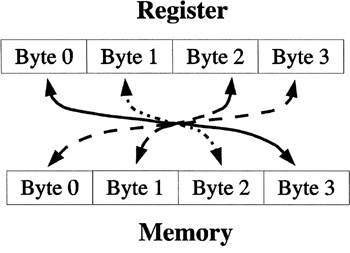Order of Bytes in a Word
One thing that confuses many people when dealing with bits and bytes on a low level is that, when bytes are written from registers to memory, their bytes are written out least-significant-portion-first. [1] What most people expect is that if they have a word in a register, say 0x5d 23 ef ee (the spacing is so you can see where the bytes are), the bytes will be written to memory in that order. However, on x86 processors, the bytes are actually written in reverse order. In memory the bytes would be 0xee ef 23 5d on x86 processors. The bytes are written in reverse order from what they would appear conceptually, but the bits within the bytes are ordered normally.
Not all processors behave this way. The x86 processor is a little-endian processor, which means that it stores the "little end", or least-significant byte of its words first.

Register-to-memory transfers on little-endian systems
Other processors are big-endian processors, which means that they store the "big end", or most significant byte, of their words first, the way we would naturally read a number.

Register-to-memory transfers on big-endian systems
This difference is not normally a problem (although it has sparked many technical controversies throughout the years). Because the bytes are reversed again (or not, if it is a big-endian processor) when being read back into a register, the programmer usually never notices what order the bytes are in. The byte-switching magic happens automatically behind the scenes during register-to-memory transfers. However, the byte order can cause problems in several instances:
-
If you try to read in several bytes at a time using movl but deal with them on a byte-by-byte basis using the least significant byte (i.e. - by using %al and/or shifting of the register), this will be in a different order than they appear in memory.
-
If you read or write files written for different architectures, you may have to account for whatever order they write their bytes in.
-
If you read or write to network sockets, you may have to account for a different byte order in the protocol.
As long as you are aware of the issue, it usually isn't a big deal. For more in-depth look at byte order issues, you should read DAV's Endian FAQ at http://www.rdrop.com/~cary/html/endian_faq.html, especially the article "On Holy Wars and a Plea for Peace" by Daniel Cohen.
[1]Significance in this context is referring to which digit they represent. For example, in the number 294, the digit 2 is the most significant because it represents the hundreds place, 9 is the next most significant, and 4 is the least significant.
EAN: 2147483647
Pages: 137